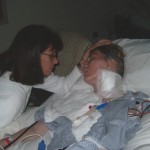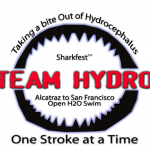Hydrocephalus Facts
What is hydrocephalus?
Hydrocephalus is a condition affecting the brain which develops when complications of a medical condition (like a stroke, tumor, head injury, or even an unknown event), cause fluid in the brain, called CSF, to build up in and around the brain to a dangerous level.
When too much CSF builds up in the head, it typically causes spaces inside the brain (called ventricles) to enlarge, putting pressure on the brain. As the pressure inside the skull continues to increase, terrible headaches, sleepiness, paralysis, dementia, and other difficult symptoms occur. Left untreated, the pressure causes severe headaches, coma, and death.
- Hydrocephalus is a life-threatening condition affecting the brain which afflicts over 1 million Americans.
- Hydrocephalus affects people of every age, from newborn babies and children, to teenagers and the oldest of adults.
- Hydrocephalus is the most common reason for brain surgery in children.
- Hydrocephalus has no cure.
What causes hydrocephalus?
Some people are born with hydrocephalus, while others develop hydrocephalus as a result of brain injury suffered from head trauma, stroke, or brain tumor. Some people develop the condition as they grow older for unknown reasons.
- Kate Finlayson, the person who inspired Team Hydro’s formation, (and also happened to be a swimmer), died from complications of hydrocephalus at age 26, after acquiring the condition as a premature baby. During her short life, she required over 100 surgeries, suffered several strokes, and endured many shunt infections and hospitalizations in an attempt to fight her condition.
- Congresswoman Gabby Giffords developed hydrocephalus after suffering head injury due to gunshot wounds.
- About 1 in every 750 children is born with hydrocephalus.
- It is estimated that 20% of people with alzheimer’s disease really have a misdiagnosed and treatable form of hydrocephalus. This condition found in older adults can be corrected with a shunt.
How is hydrocephalus treated?
The most common treatment remains the surgical insertion of a device, known as a shunt, into the brain to help drain excess fluids into other parts of the body.
- Placement of a shunt to treat hydrocephalus requires BRAIN SURGERY.
- Shunts are wonderful when working properly, but they frequently clog, break, get infected, or simply fail to work–all life threatening emergencies for the shunted person
- A shocking 50% of shunts fail and need to be revised within two years of placement!
Imagine having to undergo brain surgery every few years or more, just to stay alive!
How did Hydrocephalus get its name?
The term hydrocephalus is derived from the Greek words “hydro” meaning water, and “cephalus” meaning head. Hydrocephalus occurs when an abnormal amount of fluid exists in the head. The fluid which causes hydrocephalus is not really water however, but a liquid called cerebral spinal fluid (CSF). CSF normally exists in the brain and spinal cord of all people. People need CSF, as it performs many important purposes in the body, but unfortunately, having too much CSF can make a person very sick, or even die.
Usually the body is capable of making sure just the right amount of CSF is present in the head/brain at all times. But sometimes a person has a condition which prevents the proper flow of CSF from occurring in the brain and spinal cord . When CSF is unable to move through the body normally, too much fluid can become trapped in the brain/skull. As the amount of fluid increases it causes pressure on the brain which causes the person to develop terrible headaches and other symptoms. Without urgent treatment to correct the problem, a person affected with hydrocephalus will likely die.
What are people with hydrocephalus like?
They are wonderful vibrant human beings trying to live happy productive lives just like you. But they live with uncertainty every day knowing that at any moment their shunt could fail requiring immediate surgery.
People with hydrocephalus often suffer daily headaches and other symptoms (seizures, memory loss, motor impairment) despite their shunt working–it is just so hard to manage the pressure in the head to comfortable levels–another reason why more research and treatment options are so desperately needed!
Due to the life-long uncertainty and frequent complications of current hydrocephalus treatments, 60% of children who grow up with hydrocephalus will never live independently.
Why is More Research needed?
Despite the fact that over 1 million Americans currently suffer from hydrocephalus, and are forced to live with its devastating effects, hydrocephalus remains a relatively under-researched condition.
- Shunt technology has improved little since it was pioneered in the 1950’s and remains an imperfect and unreliable solution.
- Shunt operations for hydrocephalus cost over $1 billion a year in the US–yet the NIH funds only $1 million of research.
- About 40,000 shunt-related operations are performed every year in the US for hydrocephalus—that averages out to one every 13 minutes and over 100 every day.
- Shunts are prone to clogging , breakage, infection–treatment complications which are often deadly.
- Much is still unknown about how the brain works and why hydrocephalus develops.
It is hoped that through additional research, non-surgical options for treating hydrocephalus can be found, and that new cases can be prevented from developing in the first place!!!




